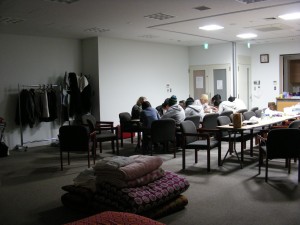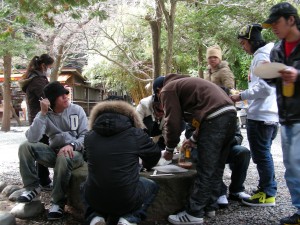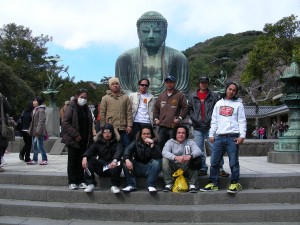I have been a writing a series (within my monthly series) for the website www.embracetransition.com.
It began as a single article: Letting Japan go… Pretty soon, however, I realised that I was not well enough (labrynthitis aggravated by bronchitis) to think it through. So what I had written became Part 1, with Part 2 promised.
Faced now with having to write Part 3, I have a sense of being close to closure on the subject. However, with a deadline looming, I’m not sure how it will begin, let alone end.
On March 11, the third commemoration of the earthquake, tsunami and meltdowns of 3/11, we got up at 5.30am to mark the exact time the earth began shaking in Japan: 5.46pm. We sat in silence in the darkness, remembering…
Remembering how life had been in Fukushima before that dreadful trembling began, and the ocean rose to sweep away so much, so many…
A mother feeding her baby. Her husband shuffling papers at the local City Office. An old man watching TV. A group of women chatting at a street corner. A taxi driver on his way to pick up a fare. School students bent over their books. The priest sweeping the steps of his shrine…
It was the time life changed for us all, and the ensuing nuclear meltdowns of the Daichii plant changed Japan forever.
Deciding that I must look back at 3/11 in order to go forward, I checked my old DOTWW blog covering the days that followed on and found what follows:
[24-3-2011] Meet a remarkably courageous group of young men (aged 22-30) from the Philippines. This evening (the day I returned to work in Tokyo) I was privileged to help them write about their experience as tsunami survivors.
On a government training scheme, they had been working as welders in a shipyard in Sendai when the quake struck. Told of a tsunami warning, some began climbing the nearest crane, others managed to cram a few valuables into rucksacks before joining their friends. They watched as the wave came in, sweeping away many of their Japanese colleagues who were trying to get home, in cars, on bikes, running… some have footage on their cellphones: terrifying. They then clung on for the next 12 hours through a night of pitch blackness and driving snow. They got very cold. All were traumatised. One of them, Khoi, and the only woman in the group that evening, Maya, who had been at home at the time, had kept diaries at some time or another, but none of the others had written anything “creative” before, let alone a poem. They created a vocabulary associated with sounds, images, feelings, then one by one wrote a sentence containing one or more of these words. They then read aloud the nine lines, and added one of their own on the end, to make it both a group effort and their own. Finally, they translated it into Tagalog, so making it wholly their own. Since English is their second language, with some being more fluent than others, I have with their permission made the tenses consistent and added one conjunction.
TSUNAMI
The tsunami was scary.
I heard a disturbing sound coming from the sea.
When the earthquake came people were panicking,
The sea was roaring,
And I saw snow, and felt thunder and lighning from the sky.
Like a nightmare that we cannot forget in our lives,
The roof was scrunched by the flood,
So we climbed up the crane and I prayed
For us to be together again someday.
By (in no particular order) Rodney F. Famorcan, Genner A Gonzaga, John Mark F.de Guip, Lito (Khoi) Bela Jr, Romnick Benalla, Christian Javier, Jacob Jaycian, Michael Brutus, Maya Kurihara
To place this in perspective, they had struggled their way inland the next morning (a horrific experience in itself) where they were found, picked up and taken to the Wesley Centre in central Tokyo. Being located close the Embassy of the Philippines, it was being used as an evacuation centre.
This was where I was running creative writing courses, and had been halfway through Level 3 when the disaster occurred, or began rather! The students were ready to start again but it took a week or so to help the evacuees move on, vacate the meeting rooms.
One evening colleague Kristin Newton and I were asked if we could occupy a small group for an hour or so. Time was hanging heavy, slow and emotional as they – Maya apart- waited to hear whether they would be relocated to other shipyards or be sent home.
Kristin, who teaches drawing (Drawing on the Right Side of the Brain), encouraged them to express their experiences and emotions on paper, using colour and images.
After my own session, I invited the group to Kamakura on the Sunday, and a woman from the embassy said that travelling money would be found, and she would bring them down by train and take them back.
It was an amazing day, that ended with a curry-rice dinner at our house in Zushi. Akii had prepared the meal while I acted as tourist guide; neighbour Yuta brought in his guitar. The boys – for so they seemed to me – disappeared on the way back into a conbeni (convenience store) and emerged sheepishly with a small sunny flowering pot plant and two cheap bottles of whisky. We then ate and sang our way through the Beatles songbook until it was time for the last train. It was, their chaperone said, the first time they had laughed as much as they had cried since that terrible day which they all said, would haunt their lives forever.
I didn’t hear from them again. I know only the names of those who were distributed around the country to continue their (so-called) training scheme. And those who were reunited with their families.
It’s good to know they are all well and moving forward in their lives. But are they? Or ought the gift of life – survival – be enough.
It’s a question I am asking myself.







